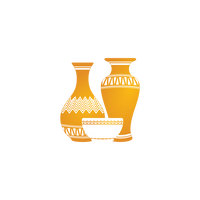
Indian pottery draws its inspiration from various historical, cultural and traditional sources. That’s why it’s so varied and so captivating. In particular, the typical pottery of the city of Khurja has its roots in the era of the Mughal Empire.
The Mughal Empire refers to the absolute monarchy which reigned in India from 1526 to 1857. Founded by Prince Bâbur, this empire with great Persian and Muslim influences gave birth to an era of exceptional flowering in arts and architecture. The fusion of the different cultures and influences present at the time (Hindu, Persian, Iranian, European, etc.) created a unique artistic style, recognized for its lightness and diversity and at the same time elegant and colorful.
Typical Mughal architecture uses red sandstone. Often, monuments are mounted in the form of capitals or domes; wall and exterior decorations are carved or molded, and gazebos are found on the roofs. The architecture is therefore very impressive and far from boring and monotonous. Regarding art, there is an intensive use of the color blue and geometric and floral patterns.
Khurja pottery, which dates from this period, drew heavily on the eclectic style of Mughal art. Indeed, the ceramic coating with bright colors which is typical of the city of Khurja is reminiscent of the technique of dry rope (corda sueca). A technique of decorating pieces of ceramic which aimed to prevent mixing colors on the piece, which was used in Mughal times and was of Iranian heritage. The use of clay and the presence of many bright colors as well as many floral and geometric patterns on the pieces of pottery produced by corda sueca were of great inspiration for the development of pottery in Khurja.
The photos below of an Iranian pitcher from the time (left) placed next to a vase from Khurja (right) demonstrate this well:


That said, it is obvious that the pottery of the city of Khurja drew much of its inspiration from Mughal art, which was the result of the fusion of many cultural and religious influences. This is why Indian pottery is so rich and fascinating. Go and discover it for yourself by consulting our latest collections, Jaipur and Khurja.
